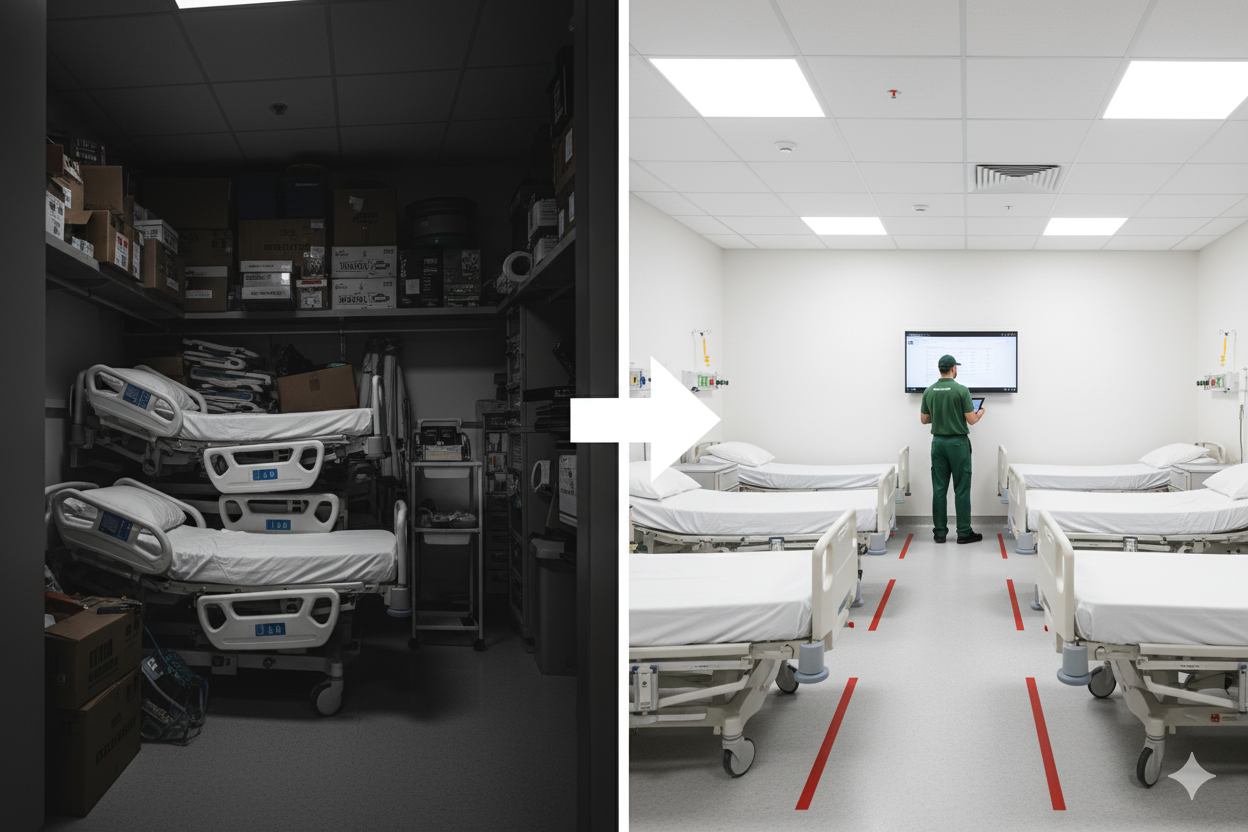
In the realm of health care, hospital bed maintenance is often an overlooked yet crucial process that significantly impacts patient care, operational efficiency and budget. As healthcare technology leaders, it’s clear that understanding and addressing the subtleties and hidden costs is key to managing our health care facility efficiently and effectively.
Understanding the Cost Subtleties of Bed Maintenance
Patient Satisfaction and Its Financial Implications: The condition of hospital beds directly influences patient safety and satisfaction, which is tied to CMS reimbursements. Beds are equipped with basic and advanced safety features, like side rails, nurse call, inflatable mattresses and bed exit alarms. These components are crucial in preventing patient falls and ensuring a positive patient experience. A hospital noticing a significant rise in patient falls may opt to rent beds that are lower to the ground or require more nursing staff to monitor patients. Either solution comes with hefty costs to the organization.
Infrequent Maintenance Visits and Regulatory Scrutiny: The irregular presence of repair technicians can lead to a cumulation of maintenance issues. To reduce technician time on-site and training requirements, OEMs often train their technicians to prioritize module-level repairs. These types of repairs are needed at times but come with significant costs. A very common and practical example can be understood when a button is worn out or malfunctioning on a footboard or siderail. A trained technician can replace the malfunctioning component, saving the hospital thousands of dollars on this single repair alone. By contrast, the OEM will often replace the entire module, even though only a minor component of the siderail or footboard warranted repair. Those modules are returned to the OEM to be “reconditioned” and resold, further incentivizing the more costly repair.
The Art of Efficient Repair with Skilled Technicians: The consistent presence of proficient technicians is fundamental to a well-run hospital bed maintenance program. If hospitals utilize undertrained technicians there’s a tendency to adopt less efficient methods — replacing parts in the hope that it will fix the issue, a practice that is not only costly but also very time consuming. At face value, bed repairs seem rudimentary enough for most qualified technicians to try and tackle; or at least perform “first-call.” Ultimately, there’s two problems with this approach. The first being that experience reigns supreme and going down the wormhole of trial and error by ordering various parts until the root issue is resolved takes valuable time away from the technician. It also drains their department of valuable time and money. Secondly, if the technician opts to save time by troubleshooting with the OEM they will likely run into the same scenario as they would with OEM on-site support: “replace the entire module at a much higher cost.”
Let’s consider the common maintenance task of addressing an error code that indicates the need for a software upgrade. If not done properly, the technician might assume there is something wrong with the control board, a pricey $1,500+ component. After ordering it, waiting several days for delivery, and finding time to replace it only to find out that was not the issue. Usually, it’s a few more parts before they realize that the upgrade procedure was not done properly and that a jump lead on the original control board needed to be reconfigured. If the bed is an ICU bed, this delay is noticed leading to complaints and loss of confidence in the hospital’s bed maintenance program. This example showcases common and costly repair sequences often performed by undertrained hospital bed technicians.
Training – A Critical Component in Preventing Damage: The way hospital beds are handled by staff, from nurses to transporters, plays a significant role in their longevity and functionality. Proper training is essential to prevent avoidable damage to the beds and the facility. Hospitals often store unused beds in rooms with small door frames leading to damaged side rails and footboards. Walls and door frames throughout the hospital are damaged by the repeated ramming of 400-pound beds. Finally, facilities managers know how expensive it is to call out to the elevator repair technicians when the elevator doors are knocked off the track or more significantly damaged. Damage to the facility is a rarely mentioned cost of the bed program but can be taken from the hospital’s financial and reputational wallet.
Rental Costs – A Temporary Fix with Long-term Implications: When repair times extend and beds become unavailable, the immediate solution is often to rent beds. However, this is a Band-Aid solution with its own set of costs, impacting the hospital’s budget in the long run. Who is tracking how many rentals are in the hospital and if they are still needed? How long does it take to determine and locate unneeded rental beds? Are you renting from the same company who repairs your beds? Is this a conflict of interest? Rental beds are easily lost in a large hospital system and without proper management can lead to missed preventive maintenance requirements and extended rental periods due to being unable to locate. It’s important that the right team is incentivized to find rental beds and get them out of the system once they’re no longer needed.
Bed Storage – The Burden of Space Constraints
Where are broken beds stored while waiting for repairs? Egress? Storing non-functional beds is a common practice but one that comes with its own set of issues and hidden costs. This storage ties up valuable space, which is a premium in health care settings, and represents a loss in the utility and efficiency of the facility. Poorly stored beds can attract negative attention from leadership and regulatory bodies when broken beds spill into common areas.
Additionally, stored beds are commonly crammed together in rooms not intended for bed storage, constantly being bumped into each other and walls. This movement can lead to significant damage to the beds and even the facility’s infrastructure. Imagine a hospital who recently invested in the latest and greatest hospital beds on the market but without noticing that the new beds were slightly wider than previous models. Unfortunately, the room used to store beds has a narrow entrance causing damage to the siderails of this brand-new investment.
The Unseen Price of Ignored Mattresses – A Sleeper Issue in Hospital Care
Integrating a mattress management program into hospital bed maintenance is a critical yet often neglected aspect, carrying hidden costs that significantly impact patient care. The lack of such a program can lead to decreased patient satisfaction, as the comfort provided by a quality mattress is essential for restful sleep and effective healing. Inadequately maintained mattresses also pose serious infection control risks, with damage potentially harboring harmful pathogens leading to hospital-acquired infections. Imagine the situation of when replacement mattresses are purchased but unfortunately, they are larger than they should be. When this occurs, the siderails can cause significant damage to the mattress leading to added costs and increased infection control issues.
The challenges of implementing a mattress management program, such as resource allocation and the need for collaboration across departments, are far outweighed by the benefits. Ignoring these aspects can result in increased health care costs due to extended patient stays and heightened infection risks.
The Importance of Standardized Processes and Simplification: Without effective standard operating procedures (SOPs), repair delays become inevitable, exacerbating the problem of bed availability, bed storage, and affecting patient care efficiency. A bed pushed into a corner with a hastily scribbled “broken” sign attached and forgotten about is common, but it’s more than just a storage issue. It represents a breakdown in communication and process, leading to unnecessary rentals, missed preventive maintenance activities and other operational inefficiencies. Continual and accumulating issues with hospital bed repair processes can lead to a gradual erosion of confidence among the clinical staff. This perception affects overall morale and impacts patient care.
Moreover, juggling various bed models under different service contracts can create inefficiencies and coverage gaps, complicating the maintenance process. There are significant hidden costs and the likelihood of error associated with administrative burden when managing multiple, high-transaction contracts. Additionally, hospitals run the risk of being susceptible to replacement vs. repair bias when working with the OEM. It’s important to consider how your outsourced support system is incentivized to ensure hidden costs are avoided.
Toward a More Efficient and Cost-Effective Approach
In light of these hidden costs, it’s evident that a strategic approach to hospital bed maintenance is not just a matter of financial prudence but also a factor in patient care quality and safety. The focus should be on proactive, efficient maintenance strategies and skilled technicians that reduce costs while enhancing service quality.
About Emeritus
At Emeritus, we recognize the intricate challenges of hospital bed maintenance and have reinvented best practices associated with keeping the vital medical devices in optimum working condition.
Our Always On-Site hospital bed repair and maintenance program ensures an outsourced expertise with an ‘in-house’ feel. We recognize the value in nurturing working relationships with your biomedical, nursing, facilities and EVS departments. The ability to respond to bed repair issues as soon as they arise with parts on-hand eliminates downtime. A skilled technician with bed expertise and personal familiarity with your inventory drastically reduces repairs and diminishes the problem of bed storage and excessive rentals altogether.
Administrative burden is alleviated through the simplified Power of One contracting. Having one firm, fixed line item to cover all your costs associated with service and parts eliminates the need to approve dozens of POs throughout the year. It also eliminates the subsequent wait times associated with parts delivery, logistics of service dispatch, as well as endless documentation.
By offering our unique, Always-On-Site hospital bed repair and maintenance program, combined with simplified Power of One contracting, we ensure minimal downtime, reduce repairs, administrative burden, and uphold staff confidence and patient satisfaction.
For more information, contact webb.clark@emerituscs.com or visit emerituscs.com.








